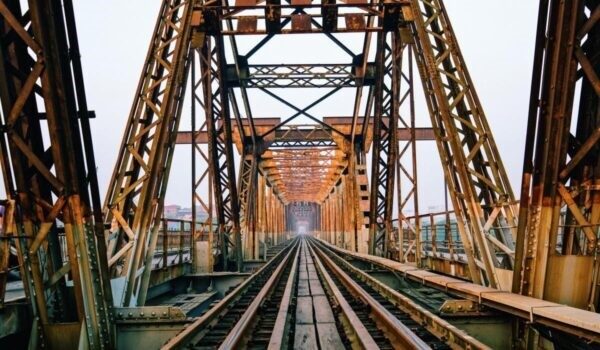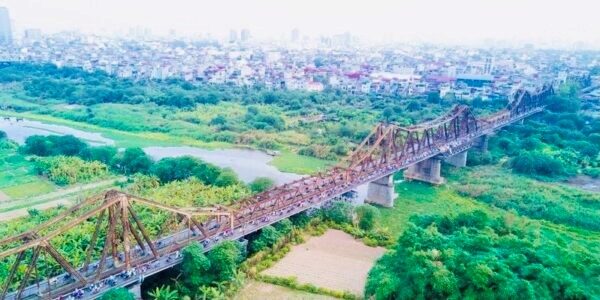Long Bien Bridge – the lifeline bridge connecting the two banks of the Red River, through many ups and downs, still stands tall and proud, becoming one of the unique typical symbols of Hanoi’s history and culture.

Long Bien Bridge has become a “historic witness” accompanying the capital for more than 100 years.
Illustration
When conducting the first colonial exploitation in Vietnam, the Governor General of Indochina Paul Doumer had the idea of building a large steel bridge across the Red River connecting traffic from Hanoi to Hai Phong, Lang Son, Lao Cai and the northern provinces. After 3 years of construction (1899-1902), the completed bridge has a length of 2,290m across the river and 896m of the accessing bridge, including 19 steel beam spans placed on 20 pillars, looking like “a green dragon crossing the water, rainbow band supporting the sky”. The bridge has a railway lane running in the middle and two road lanes on both sides. At that time, the bridge was the pride of colonial Indochina. Along with the inauguration of the bridge, the Governor General of Indochina allowed the railway from Hanoi to the Vietnam – China border, the Hanoi – Gia Lam section has been put into operation on April 8, 1902. Initially, the bridge was named Paul Doumer, but people often call it Cai River Bridge or Red River Bridge. When the whole of Hanoi had only Long Bien bridge across the Red River, all vehicles, cars, trains, motorbikes, rudimentary vehicles, and pedestrians were traveling on this bridge.

The image of Long Bien Bridge is forever beautiful in the minds of Hanoians.
Illustration
Long Bien Bridge became a strategic traffic artery buckling through the ravages of war. The bridge was tilted because of the lines of French colonial tanks sending troops from the city to Gia Lam airport to strengthen the Dien Bien Phu battlefield. In 1954, Long Bien Bridge continued to witness the withdrawal of the French expeditionary force from Hanoi; at the same time welcomed our soldiers bravely to take over the capital in the joyful atmosphere of thousands of compatriots. During the war of sabotage in the North by the US air force, Long Bien Bridge was the only bridge in the journey of transporting goods by road and rail from Hai Phong port, from the northern border to Hanoi to the large and small roads to support the southern battlefield. Therefore, from 1965 to 1972, American aircraft bombed 14 times to destroy the bridge. Vietnam’s engineer and air defense troops and Hanoi’s militia and self-defense forces have built many anti-aircraft artillery positions, waiting all day for American planes to fire, ready to sacrifice both their lives and the battlefield to protect the bridge. Long Bien Bridge is not only a resilient symbol of Vietnam’s traffic but also symbolizes the bravery and bravery of Hanoi capital during the years of anti-Americanism. Peace was restored, the old and wounded bridge continued to bear the increasing weight for the development of the capital and the country until two new bridges, Thang Long and Chuong Duong, were completed. Due to the long use time and the daily “burden” of thousands of vehicles, the bridge was seriously degraded. The bridge is still in the process of being repaired and upgraded under the bridge maintenance, upgrade and repair project until 2025.
More than a century has passed, values from Hanoi’s heroic past are still deposited on each span of Long Bien Bridge. It has become a “historical witness” associated with the development history of the Capital and is forever beautiful in the minds of Hanoians.
Mai Chi

